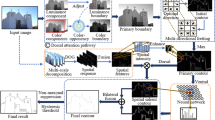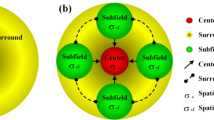Abstract
We propose a new method of image contour detection, considering the close relationship between binocular parallax in the biological vision system and the hierarchical transmission of visual channel information flow. Firstly, we present the dynamic adjustment mechanism of different opponent cell connection weights in a color channel to obtain the initial contour response diagram. Subsequently, we introduce the binocular parallax energy model to separate the image feature information to receive the response of position and phase differences; we then construct the end-stopped cells with different phases to extract the primary contour of the image to a significant extent. At the same time, we propose a multi-scale receptive field fusion strategy to suppress the local texture with multi-intensity. Finally, we use the feedforward mechanism across the hierarchy to refine the textured background and improve the primary contour contrast to obtain the final contour response. Our image processing method based on binocular parallax compensation can provide a new idea for subsequent studies on the higher visual cortex's image understanding and visual cognition.







Similar content being viewed by others
References
Mignotte, M.: A biologically inspired framework for contour detection. Pattern Anal. Appl. 20, 365–381 (2017)
Trokielewicz, M., Czajka, A., Maciejewicz, P.: Post-mortem iris recognition with deep-learning-based image segmentation. Image Vis. Comput. 94, 103866 (2020)
Rasheed, W., Neoh, Y.Y., Bin, H., Nor, H., Reza, F., Idris, Z., Tang, T.B.: Early visual analysis tool using magnetoencephalography for treatment and recovery of neuronal dysfunction. Comput. Biol. Med. 89, 573–583 (2017)
Tao, H.J., Lu, X.B.: Contour-based smoky vehicle detection from surveillance video for alarm systems. Signal Image Video Process. 13, 217–225 (2019)
Gupta, D., Anand, R.S.: A hybrid edge-based segmentation approach for ultrasound medical images. Biomed. Signal Process. Control 31, 116–126 (2017)
David, W., Daisuke, D., Yasutomo, K., Ichiro, I., Hiroshi, M.: Regression of feature scale tracklets for decimeter visual localization. Image Vis. Comput. 68, 53–63 (2017)
Kosala, G., Harjoko, A., Hartati, S.: Robust license plate detection in complex scene using MSER-dominant vertical sobel. IAENG Int. J. Comput. Sci. 47, 214–222 (2020)
Goulart, J.T., Bassani, R.A., Bassani, J.W.M.: Application based on the Canny edge detection algorithm for recording contractions of isolated cardiac myocytes. Comput. Biol. Med. 81, 106–110 (2017)
Sun, X., Shang, K., Ming, D., Tian, J., Ma, J.: A biologically-inspired framework for contour detection using superpixel-based candidates and hierarchical visual cues. Sensors. 15(10), 26654–26674 (2015)
Akbarinia, A., Parraga, C.A.: Feedback and surround modulated boundary detection. Int. J. Comput. Vision 126, 1367–1380 (2018)
Michael, W.: Spratling, Image segmentation using a sparse coding model of cortical area v1. IEEE Trans. Image Process. 22, 1631–1643 (2013)
Lin, C., Zhang, Q., Cao, Y.: Multi-scale contour detection model based on fixational eye movement mechanism. Signal Image Video Process. 14, 57–65 (2020)
Fang, T., Fan, Y.L., Wu, W.: Salient contour detection on the basis of the mechanism of bilateral asymmetric receptive fields. Signal Image Video Process. 14, 1461–1469 (2020)
Wang, G., Beats, B.D.: Contour detection based on anisotropic edge strength and hierarchical superpixel contrast. Signal Image Video Process. 11, 1–9 (2019)
Cao, Y.J., Lin, C., Pan, Y.J., Zhao, H.Z.: Application of the center-surround mechanism to contour detection. Multimed. Tools Appl. 78, 1–21 (2019)
Anzai, A., Ohzawa, I., Freeman, R.D.: Neural mechanisms underlying binocular fusion and stereopsis: position vs. phase. Proc. Natl. Acad. Sci. USA. 94, 5438–5443 (1997)
Zeng, C., Li, Y.J., Li, C.Y.: Center-surround interaction with adaptive inhibition: a computational model for contour detection. Neuroimage 55, 49–66 (2011)
Kruger, N., Janssen, P., Kalkan, S., Lappe, M., Leonardis, A., Piater, J., Rodriguez-Sanchez, A.J., Wiskott, L.: Deep hierarchies in the primate visual cortex: What Can we learn for computer vision? IEEE Trans. Pattern Anal. Mach. Intell. 35, 1847–1871 (2013)
Freeman, J., Ziemba, C.M., Heeger, D.J., Simoncelli, E.P., Mocshon, J.A.: A functional and perceptual signature of the second visual area in primates. Nat. Neurosci. 16, 974–981 (2013)
Rodríguez-Sánchez AJ, Tsotsos JK (2011) The importance of intermediate representations for the modeling of 2D shape detection: endstopping and curvature tuned computations. In: IEEE Computer Society Conference on Computer Vision and Pattern Recognition, pp 4321–4326
Chen, Z.K., Cai, R.T.: Contour detection by simulating the curvature cell in the visual cortex and its application to object classification. IEEE Access. 8, 74472–74484 (2020)
Arbeláez, P., Maire, M., Fowlkes, C., Maliket, J.: Contour detection and hierarchical image segmentation. IEEE Trans. Pattern Anal. Mach. Intell. 33, 898–916 (2010)
Yang, K.F., Gao, S.B., Guo, C.F., Li, C.Y., Li, Y.J.: Boundary detection using double-opponency and spatial sparseness constraint. IEEE Trans. Image Process. 24, 2565–2578 (2015)
He, J.Z., Zhang, S.L., Yang, M.: BDCN: Bi-directional cascade network for perceptual edge detection. IEEE Trans. Pattern Anal. Mach. Intell. 44, 100–113 (2019)
Wang, Y., Wang, L., Qiu, J., Yang, Y.Y.: Feature enhancement: predict more detailed and crisper edges. Signal Image Video Process. 15, 1635–1642 (2021)
Mély, D.A., Kim, J., Mcgill, M.: A systematic comparison between visual cues for boundary detection. Vis. Res. 120, 93–107 (2016)
Acknowledgements
This work was supported by the National Natural Science Foundation of China through Grant No. 61871427.
Author information
Authors and Affiliations
Corresponding author
Additional information
Publisher's Note
Springer Nature remains neutral with regard to jurisdictional claims in published maps and institutional affiliations.
Rights and permissions
About this article
Cite this article
Wei, C., Fang, T., Fan, Y. et al. Contour detection based on binocular parallax perception mechanism. SIViP 16, 1935–1943 (2022). https://doi.org/10.1007/s11760-022-02154-x
Received:
Revised:
Accepted:
Published:
Issue Date:
DOI: https://doi.org/10.1007/s11760-022-02154-x




